Blog
6 learnings from the FT Strategies Summit
Last week, FT Strategies and Google News Initiative (GNI) invited over 150 news media executives to London on an exclusive summit discussing News In The Digital Age. Our team was there as well. Thank you, FT Strategies for the invite.
From the rich agenda involving more than 30 speakers over 12 panel discussion, 6 key learnings stood out:
- European publishers are among the most sustainable in the world
- Scaling for growth requires a clear north star
- We need to continue to invest in engagement science, product and growth
- Advertisers returning to publishers for access to more complete data
- Innovative multimedia storytelling generates extra engagement
- Young generations expect authenticity and community
European publishers are among the most sustainable in the world
During an 18 months project involving 450 publishers, FT Strategies and GNI built a tool to assess the long term sustainability of newspapers. The tool calculates a sustainability score and provides recommendations for improvement. Publishers can use the sustainability score to benchmark their own organisation.
The analysis of the project team, shows that European publishers are among the most sustainable in the world, slightly above North American publishers. In terms of monetisation, European and Oceanian newspaper publishers are best in class.
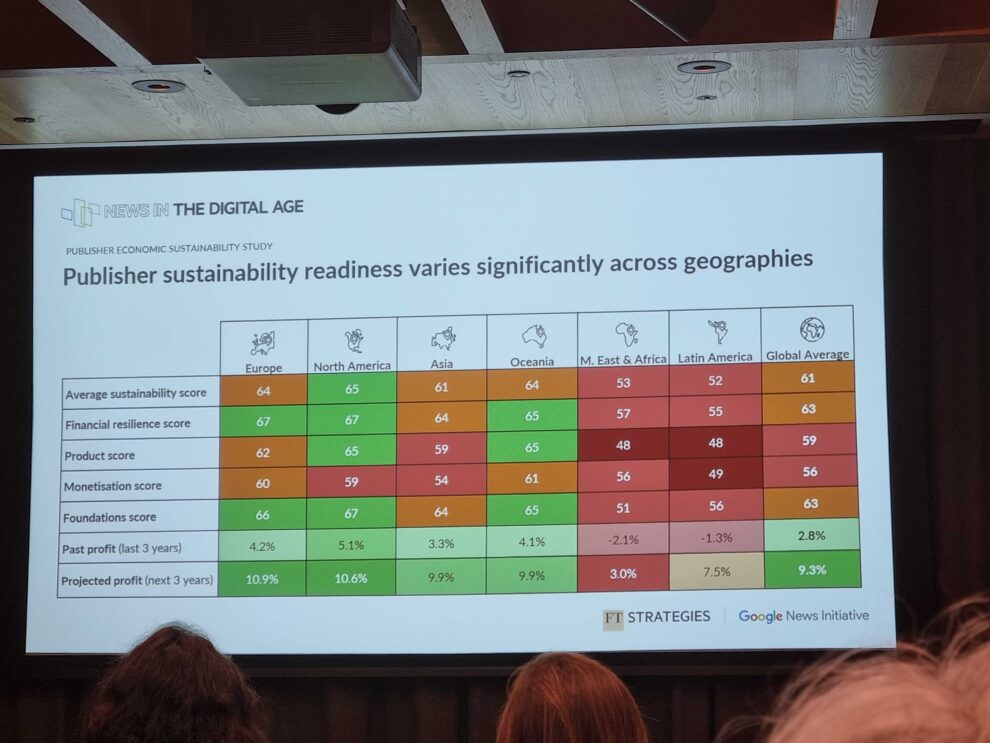
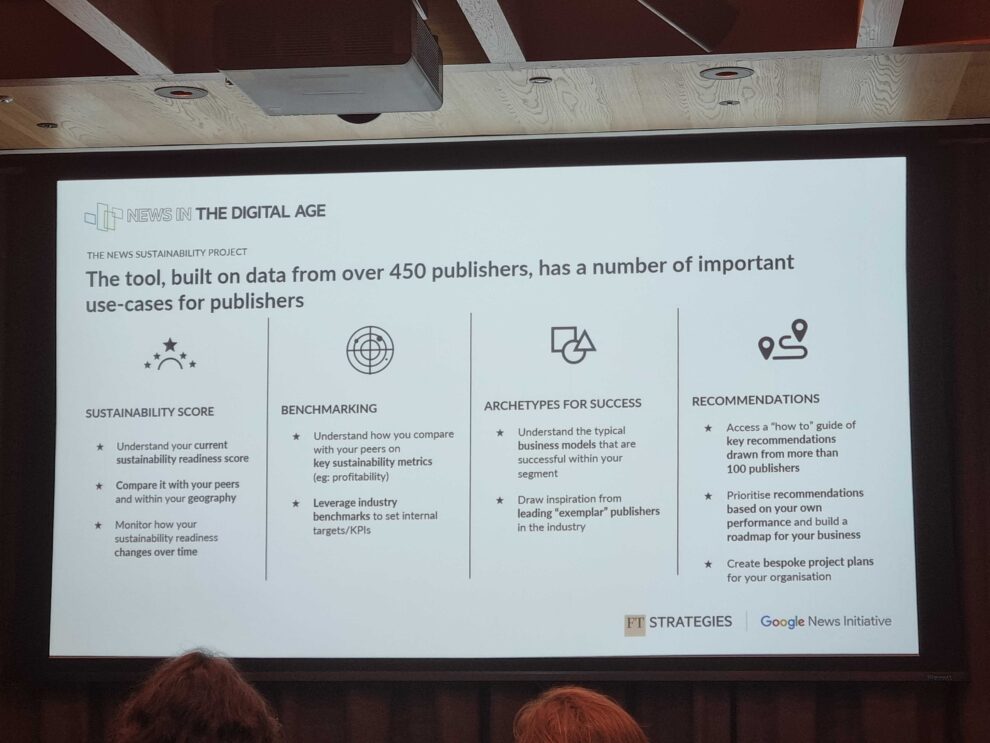
European publishers have successfully transitioned to digital-first models, invested in high-quality journalism, and built loyal audiences through subscription services. By focusing on sustainable growth, they have been able to weather the storm and remain relevant in a changing media landscape.
☀️ A note of optimism: Financial Times CEO John Ridding joined the cautious optimism felt throughout the event.
“The FT has never had more paying readers in its 135 years of history. We now have a paid audience of 1,3 million readers, and a monthly reach of 26 million. The potential is still huge.”
Scaling for growth requires a clear north star
In a panel addressing the challenges of scaling, Jon Slade – Chief Commercial Officer at The Financial Times, Cliona Mooney – Director of Subscription Insights at Irish Times, Barbara Kaija – Editor in Chief at News Vision Uganda and Eero Korhonen from GNI discussed about the importance of culture building, especially in hybrid organisations.
“The main ingredient for a successful growth strategy is the organisational culture,”
Eero Korhonen, Partnerships Lead News & Publishers EMEA at Google.
One key to scaling for growth for newspaper organisations is defining a north star that is relevant organisation-wide and can mobilise everyone. This means setting goals and defining a vision beyond financial metrics. Goals that every team in the organization can rally around.
The Telegraph is a great example. In 2019 they clearly formulated their “10-1-23 strategy”: 10 million registrants and 1 million subscriptions by 2023. This has served as guiding north star for the organisation ever since.
Such a north star strategy should be build on 4 core principles:
- Empowerment: Ensuring that everyone has the opportunity and permission to contribute to the operation of the north star
- Collaboration: Working effectively together in a single journey to deliver the north star goal
- Transparency: Sharing strategy, roadmap and all results in a timely and open manner throughout the whole organisation
- Being evidence-based: Being data-informed in deciding the ways in which the north star can be achieved
The panellists explained that creating the strategy is just the beginning. Multiple roadblocks can drive newspaper organisations to deviate from their north star strategy. To overcome these roadblocks the whole organisation should be committed to measure their progress, identify and correct deviations and re-define goals when needed.
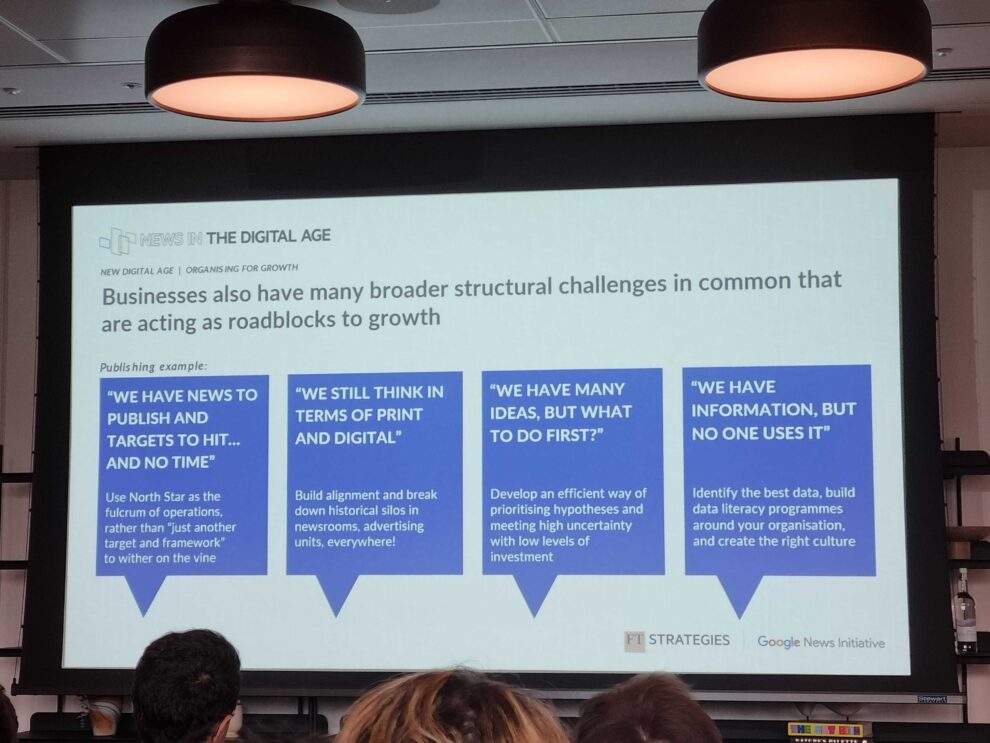
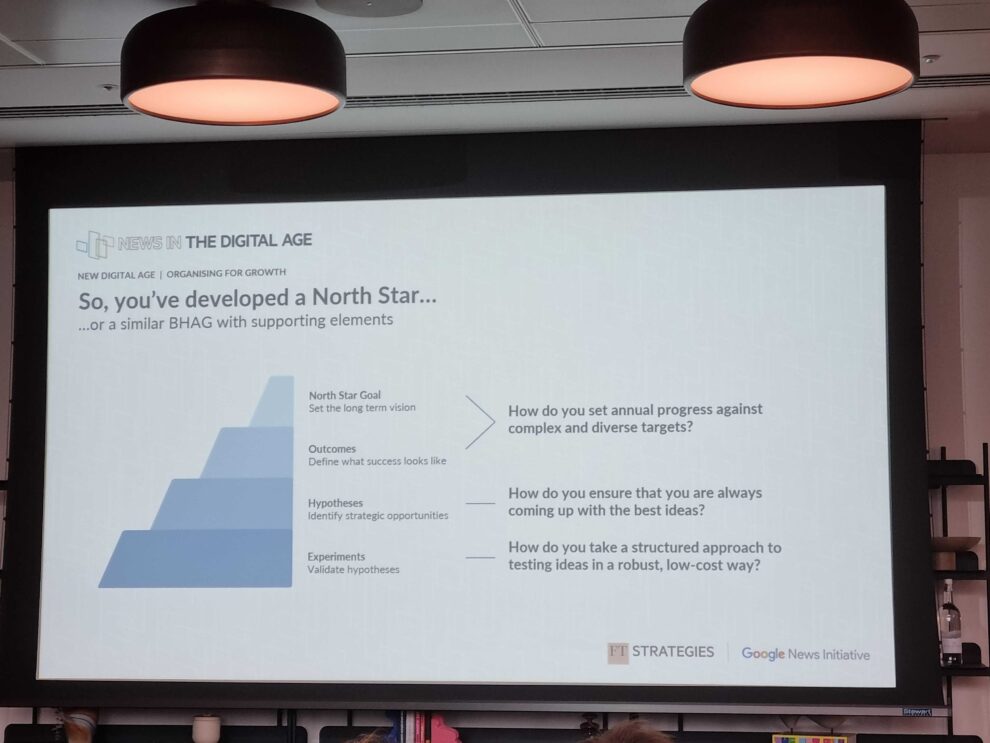
We need to continue to invest in engagement science, product and growth
News is still the core of the product offering for newspaper companies around the world.
“In a world of multiple crises, people return to quality, reliable, accurate and authoritative journalism”
John Ridding, CEO Financial Times.
Mathias Douchet, Product Director at The Telegraph, spoke about the importance of investing in both content and products to be able to reach the ambitious 1 million subscribers goal.
Unique journalistic content like the recent unveiling of the Lockdown Files by The Telegraph has generated uplift in engagement and recurring reading.

Publishers should further develop a deeper understanding of what drives reader engagement. John Ridding, made a clear call towards the publishers present to plan to “invest even more in enegagement science”.
🧐 Research Deep Dive: At Twipe we launched an academic research project with KU Leuven and Mediahuis on measuring and understanding reader engagement already in 2015. This was probably one of the first attempts to take a scientific approach to this important issue and has resulted in ongoing research.
Advertisers returning to publishers for access to more complete data
While a subscriber centric strategy is still key, advertising revenues remain important.
“It is not an either or story, between reader revenues and ad revenues. With a clear focus on readers, we can also offer a high quality advertising offering,”
John Ridding – CEO, Financial Times
In a world where correct and complete data is becoming more and more valuable, publishers can regain ground in the fight for advertising revenues.
Joe Root, Co-Founder at audience tech company Permutive, explained that only 30% of audiences allow tracking of data to enable ad placement on open market places.
In this context, more advertisers are returning to publishers for access to complete, first-party data, that allows higher quality targeting. A great opportunity and competitive advantage that publishers should learn to leverage.
This requires however investing in a global data strategy that caters to all the different data needs spanning from product, content, marketing, advertising. To address this, the FT has established a committee for data governance. They serve as single entity that can oversee all the sources of data, decide it can be used for and what is shared with who.
💡 Pro Tip: One way this can be achieved is through data clean room technologies that can help publishers keep first person user data private when interacting with advertising providers.
Innovative multimedia storytelling generates extra engagement
Visual storytelling increases significantly the impact of a journalistic effort. Three stunning examples from news organisations were shared during the summit.
1. The Daily Maverick’s “Eve of Destruction”
Branko Brkic, the Editor-in-Chief of the South African The Daily Maverick blew the audience away showing the video production “Eve of Destruction.”
2. The Financial Times’ “From Paradise to Hell”
Sam Joiner, Visual Stories Editor of the Financial Times, shared as well impressive cases of new innovative story formats his team have been working on.
In “From Paradise to Hell”, his team brought a controversial and insightful story about the real estate construction issues that are partly at the root cause of the massive amount of deaths after the recent earthquake in Turkey. The team made smart use of open source data like satellite images as well as the drone coverage of the villages.
3. Tifo Football’s Activation Energy Formula for engaging visual content
Jonathan Mackenzie – Executive Producer for Sports Media Company Tifo Ireland explained the concept of Activation Energy. This is a formula his team uses to assess whether a topic is worthwhile covering and publishing.
With 550k views, Tifo’s best performing video so far is “Why Brighton defenders put their studs on the ball”. This video does not cover any of the top Premier League clubs in the UK but still it attracted their largest audience ever. Jonathan argued this linked to it having a high Activation Energy.
Aside from the content that will be critical for audience to stay engaged with the story, three key elements have to be in place to drive the Activation Energy:
- Thumbnail: Tifo Football now has 1 full time thumbnail artist focusing on this. It has to be colourful, and raise the curiosity of the reader.
- Headline: “We never start producing the content, until we have the headline right”.
- Brand authenticity: The brand identity must be recognisable throughout the entire story.
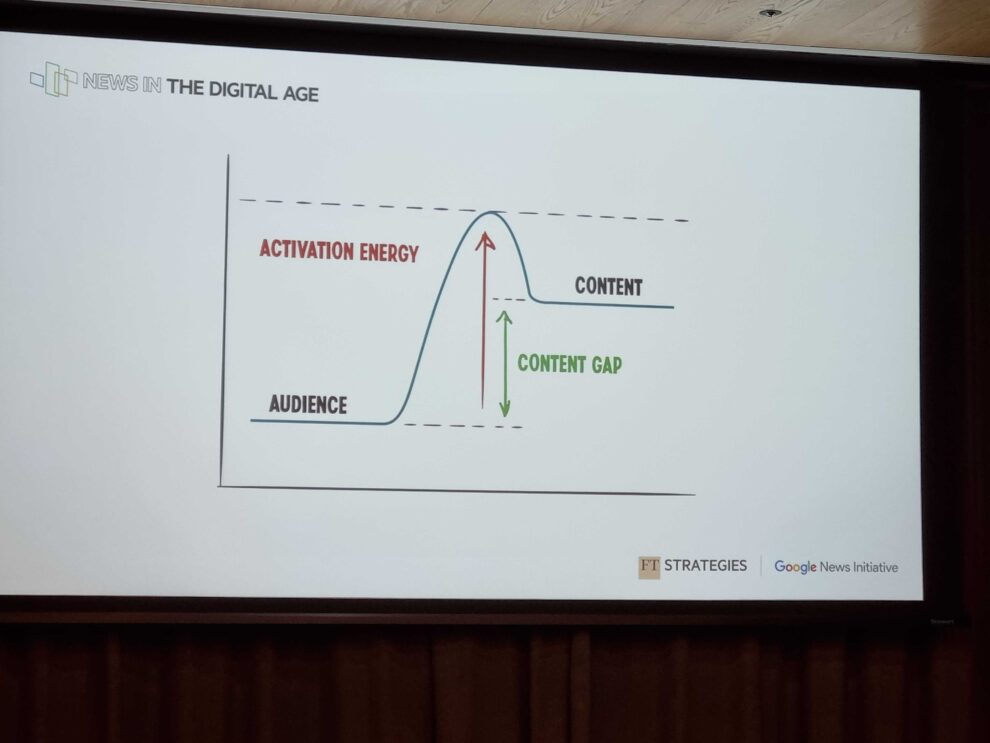
Young generations expect authenticity and community
Jack Kelly, CEO and Founder at popular newsletter and social media outlet TLDR addressed ways to engage Gen Z on a panel together with Elena Corchero and Nic Newman. TLDR is powered by a team of 10 people and have reached an impressive 2 mio subscribers with 10million monthly active users.
According to Jack, one of the most important factor for engaging young people is that they can identify themselves with the brand. A young face or spokeperson is very important. This builds on the authentic mission of the brand. The 10 people behind TLDR are between 20 and 28 years old.
“I am a good proxy for our audience. I am interested in many topics, but not that knowledgeable. You need to find similar people who can help to assess the content quickly. If they are confused, don’t move forward.”
Jack Kelly – CEO and Founder TLDR
The type of content and tone of voice that resonates with people in this group according to Kelly is also more educational and explanatory. TLDR always focus on the 2nd order questions linked to the event, positioning their news as explainers that come 24-48h after the events.
During our Seminar in NYC, we heard as well that for engaging Gen Z the focus should be more about presence in people’s life and community and authentic brand building across the platforms where Gen Z spends time.
It should not be about convincing to pay as truth is that people are in different stages of their lives.
“Young people did not buy newspapers 30 years ago either”
– Douglas McCabe, CEO of Enders Analysis
This is a topic we will also tackle during this year’s Digital Growth Summit. The key theme will be How do we engage readers from the different generations. The summit takes place in Brussels on September 27th. Register in the next 30 days to benefit from early bird rates.
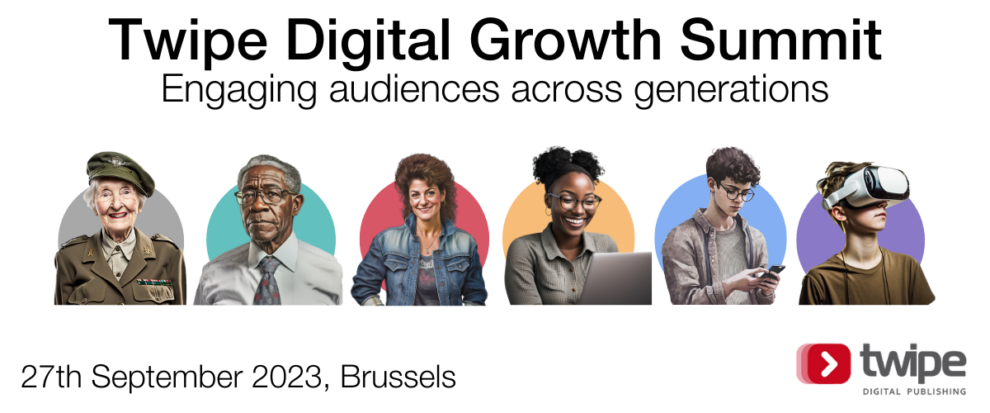
Other Blog Posts

Stay on top of the game
Subscribe to Twipe’s weekly newsletter to receive industry insights, case studies, and event invitations.
"(Required)" indicates required fields

